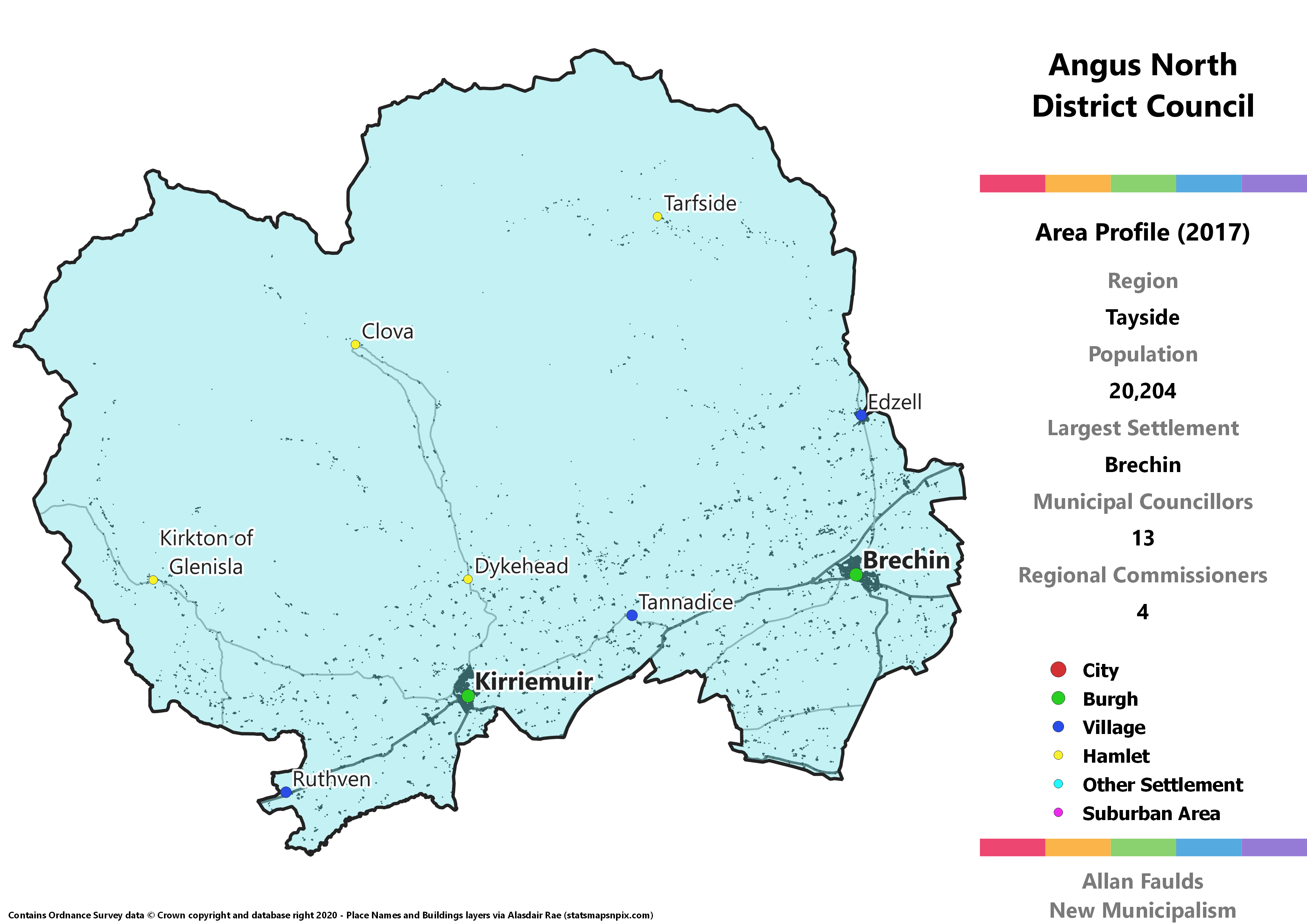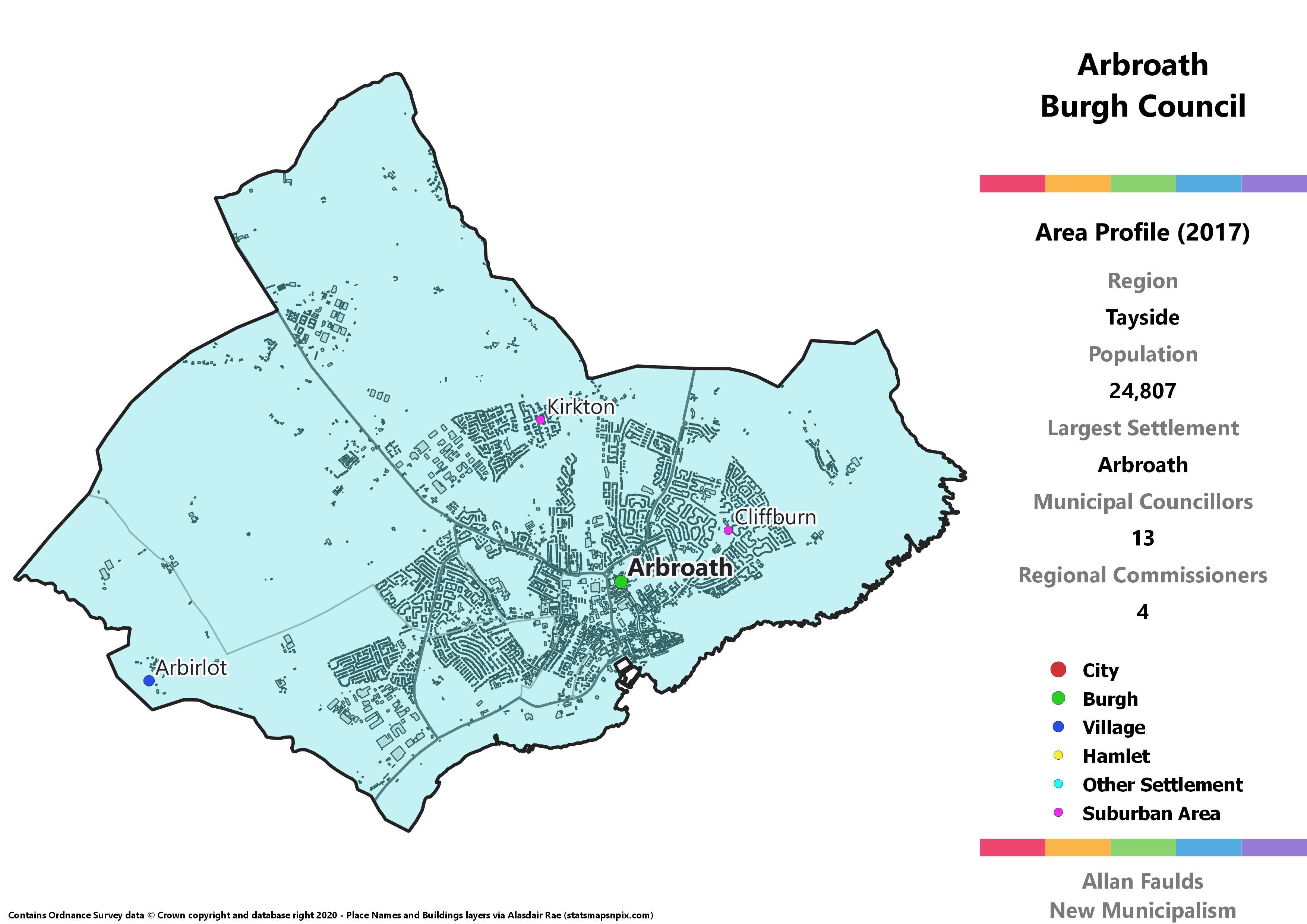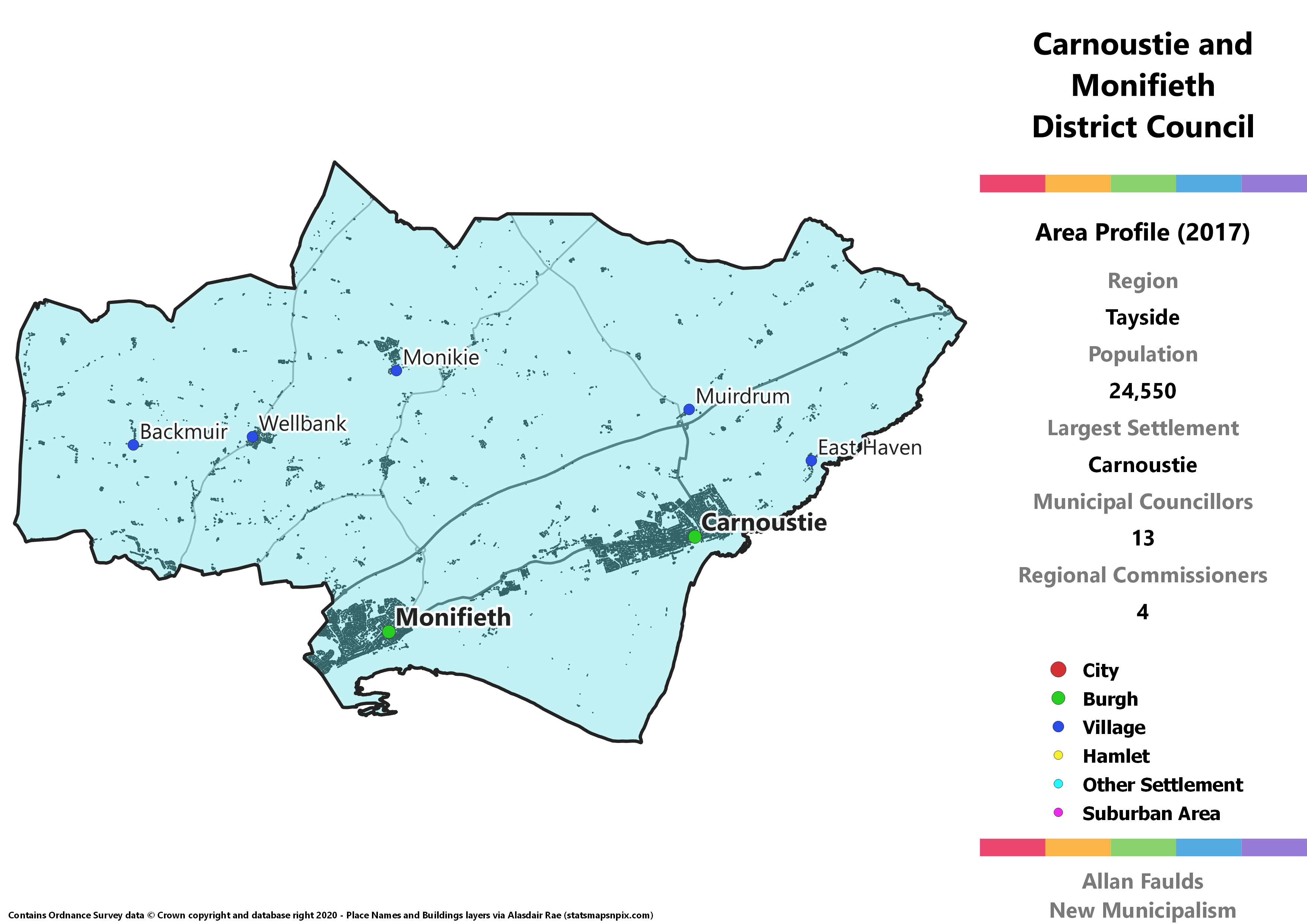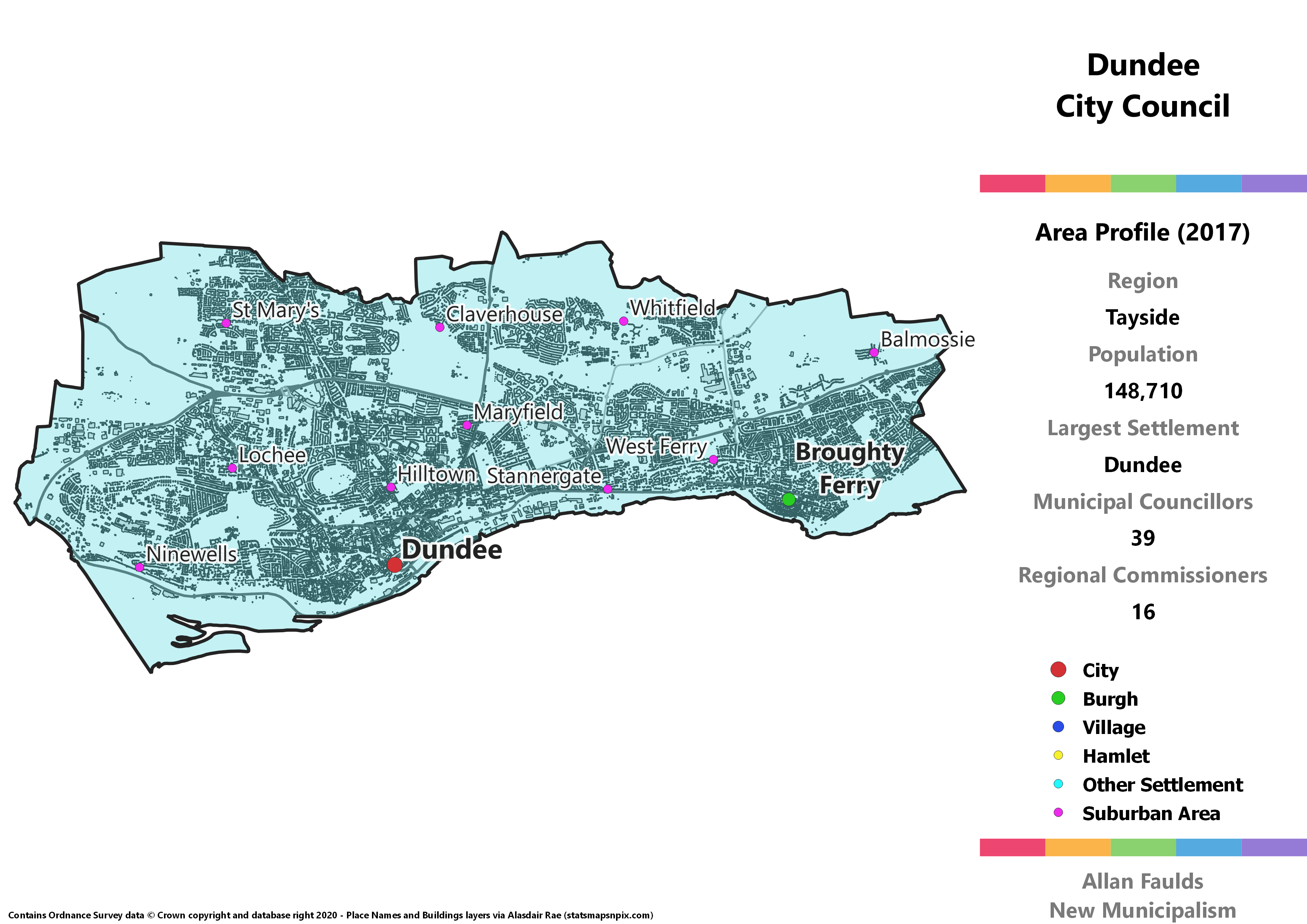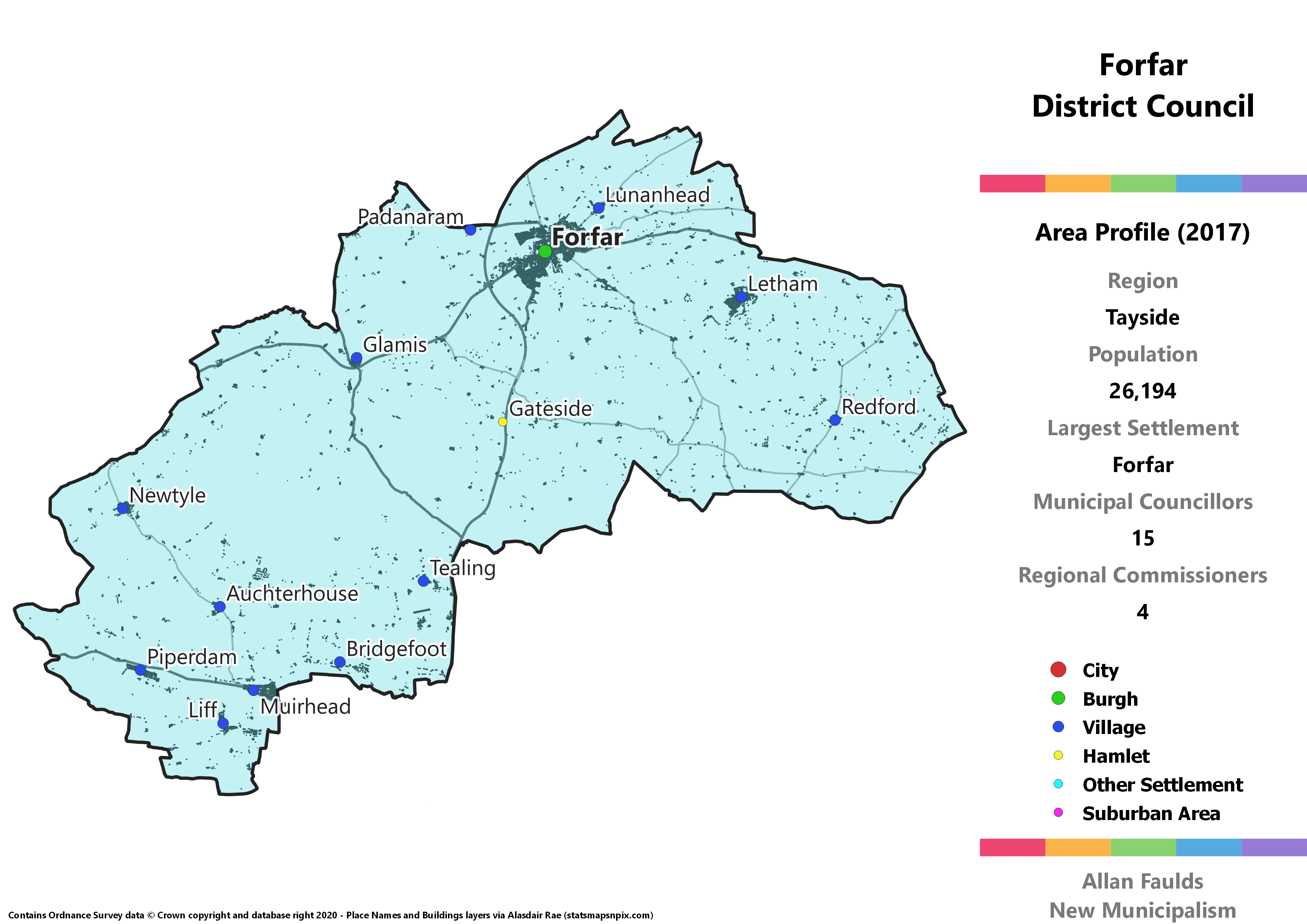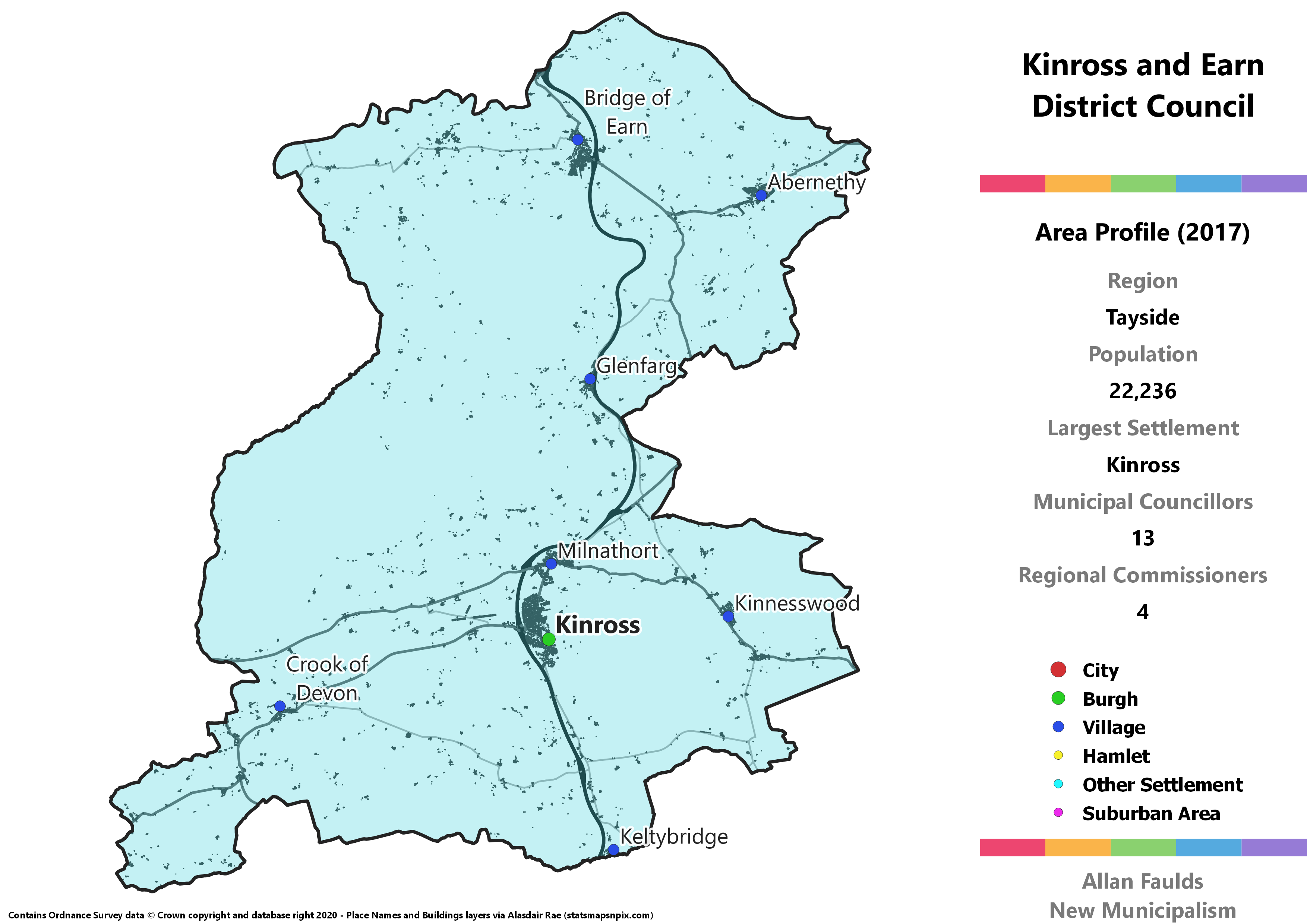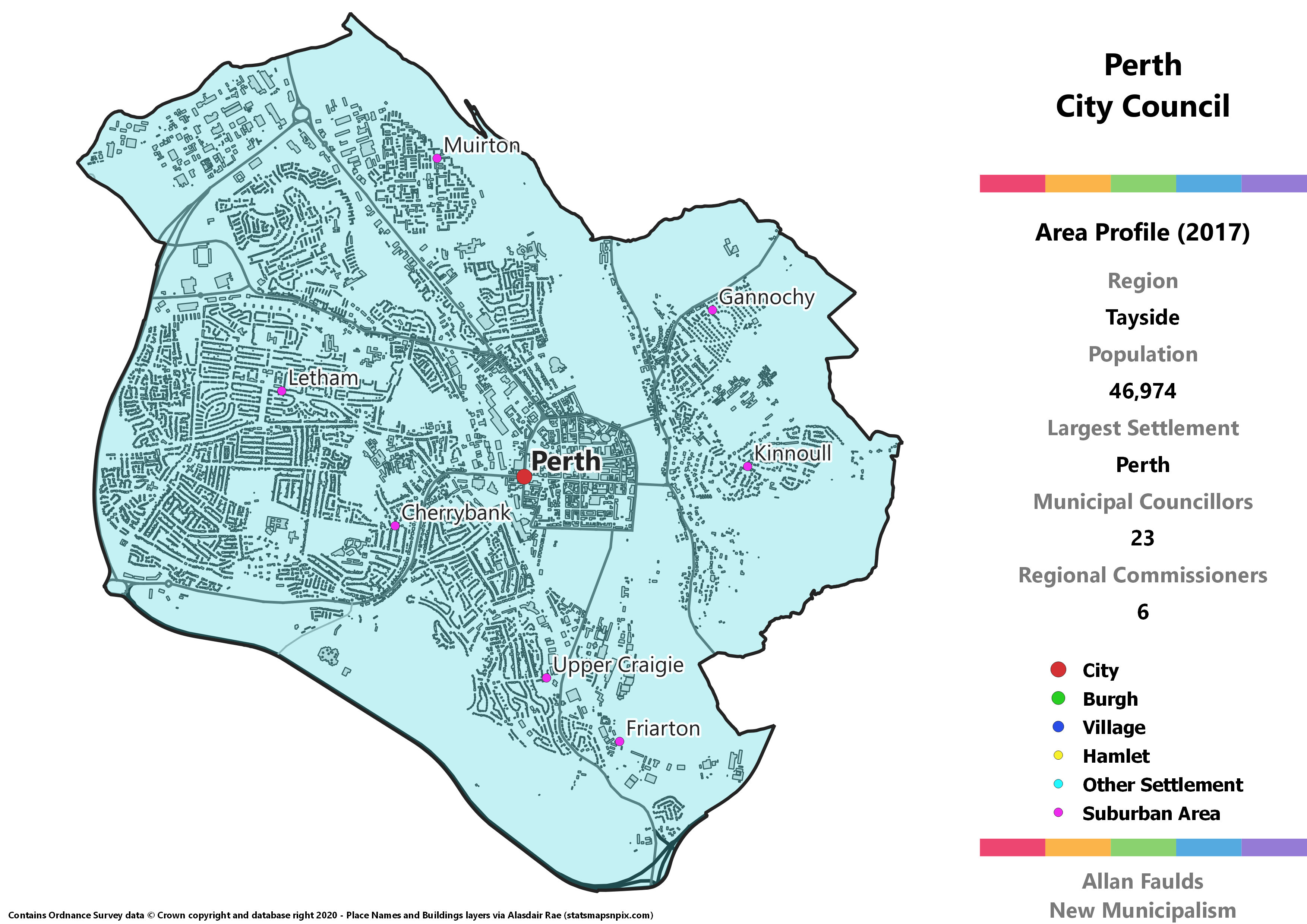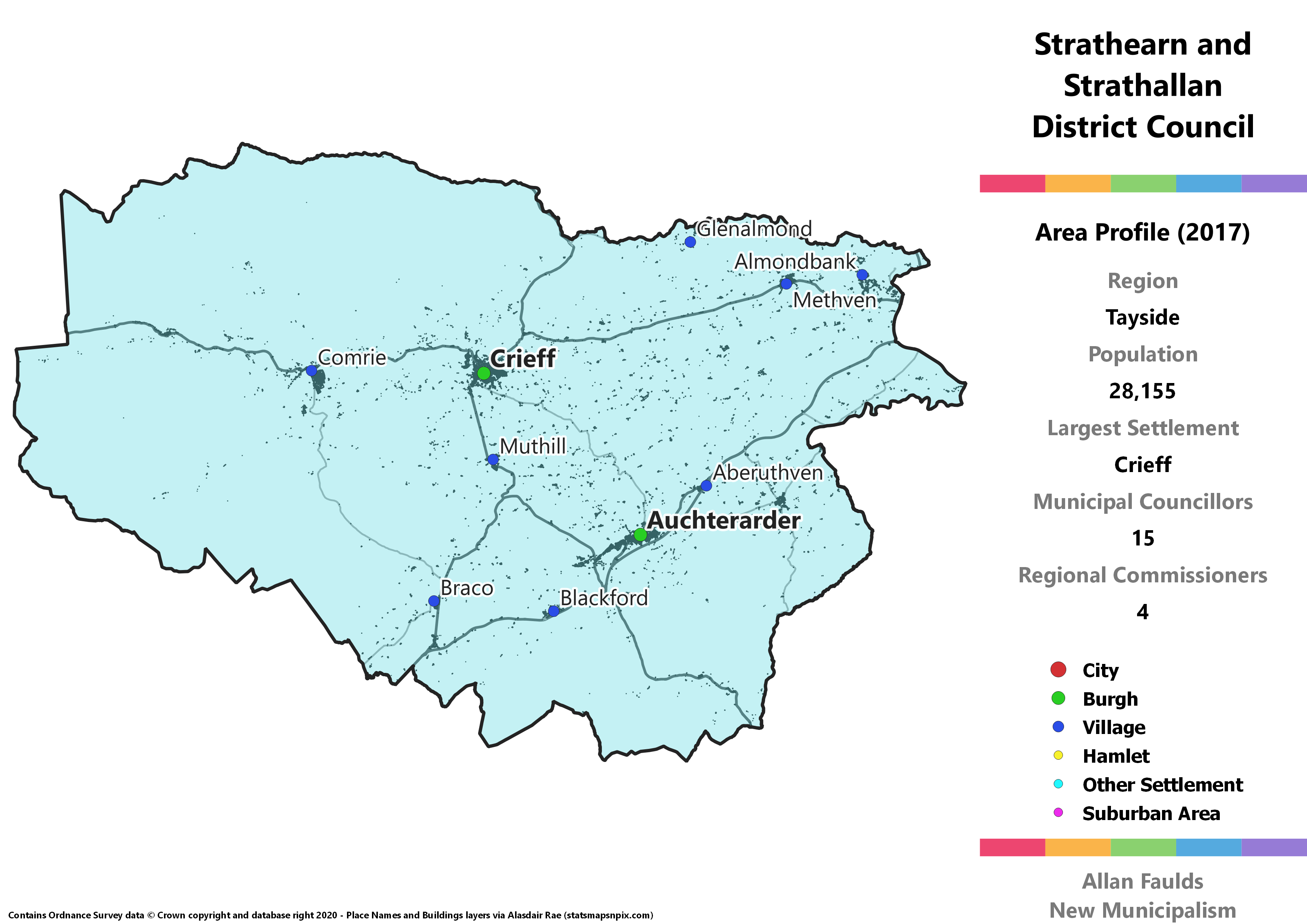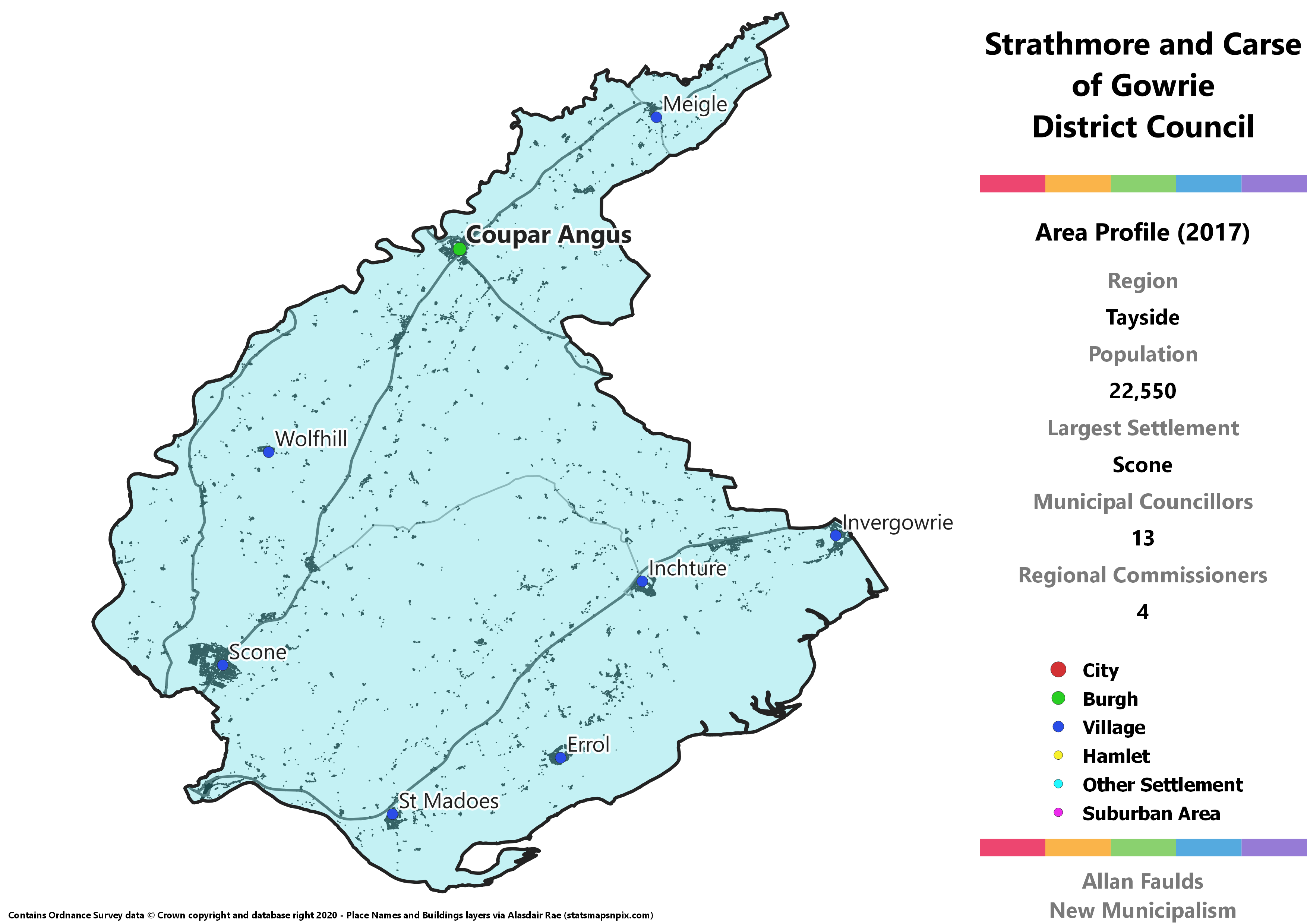Tayside Region Overview
Key Statistics
Municipalities: 11
Population: 417,608
Largest Settlement: Dundee
Municipal Councillors: 187
Regional Commissioners: 59
Region Description
In principle, the 1973 Act’s Tayside Region was perfectly sound, so it’s no surprise to see the basic outline resurrected in this project. As you’d expect though, where it differs is in having a wider range of underlying municipalities. This Region includes the current Angus, Dundee and Perth & Kinross Councils, which were the Districts in the previous setup. That means in historic terms it takes in Angus, Kinross-shire and most of Perthshire, sans a large chunk that was given over to Stirling and a much smaller one to Clackmannanshire under that Act. By a quirk of history, this would be the only region to contain two cities, as Perth sits just a bit further up the Tay than Dundee.
Unlike Scotland’s two largest cities I haven’t given Dundee, the fourth largest, a unitary authority. The fear with the big two was that they’d overpower the surrounding areas or go too far in terms of dismantling historic neighbouring counties. Neither of those issues apply to Dundee. In population terms it’s about 35% of Tayside, and as Regional Councils weight against larger municipalities, only 27% of the seats.
Translating 2017 results up to a hypothetical Regional Council, Tayside would have representation from all five major parties. Overall however, the SNP and Conservatives play a dominant role here, having historically been the two major players in both Angus and Perth & Kinross, whilst Labour squared off against the SNP in Dundee. There also tends to be a bit of a political distinction between the cities and the coastal Burghs of Angus and the more rural interior.
Angus North District
Area Profile (2017)
Population: 20,204
Largest Settlement: Brechin
Municipal Councillors: 13
Regional Commissioners: 4
Municipality Description
Coming in just over the threshold, Angus North takes in the vast but very sparsely inhabited expanse of the Angus Glens plus the former Burghs of Brechin and Kirriemuir along the south. This is basically a pretty typical inland rural municipality, right down to having highly popular Independents whose votes don’t translate very well into a simple list electoral system, boosting the seat numbers for the parties. That’s also likely to explain how this is the only Angus municipality with no Labour councillor.
Arbroath Burgh
Area Profile (2017)
Population: 24,807
Largest Settlement: Arbroath
Municipal Councillors: 13
Regional Commissioners: 4
Municipality Description
With Dundee having been on its own for over a century now, Arbroath has served as the largest town in the county of Angus. It’s a place weel kent at least by name to many Scots thanks to the 14th Century “Declaration of Arbroath”, which perhaps holds a place in Scottish constitutional history equivalent in importance (if not in effect) to the English Magna Carta. It remains an important town to this day, and formerly had its own Burgh Council. Restoring that historic status is an easy target for this project, given the size of the town.
Blairgowrie and Strathtay District
Area Profile (2017)
Population: 32,703
Largest Settlement: Blairgowrie
Municipal Councillors: 17
Regional Commissioners: 5
Municipality Description
This massive District covers most of Perthshire, with a large chunk of the population concetrated in the southeast around the old twin Burghs of Blairgowrie and Rattray. The rest of the population can be seen in those trailing fingers of buildings that follow the course of a number of rivers, most prominently the Tay which passes by Aberfeldy and the Tummel which passes Pitlochry. There are also less populous tracts along the Ardle and Garry.
Based on 2017 results, Blairgowrie and Strathtay would be one of the least diverse councils in Scotland. Only the Conservatives and SNP would win seats, and the former a majority. Labour were just a fraction of a percent away from a seat, whilst the Lib Dems were quite far off, this being the only Perthshire municipality they aren’t present on.
Carnoustie and Monifieth District
Area Profile (2017)
Population: 24,550
Largest Settlement: Carnoustie
Municipal Councillors: 13
Regional Commissioners: 4
Municipality Description
Carnoustie and Monifieth incorporates those two historic Burghs along the coast, plus some much smaller villages a little way into the rural interior. Under the 1973 Act, Monifieth was part of Dundee City District (as was a large chunk of that countryside). It’s easy to see the logic for that as the two have grown into one another, but given my tendency to avoid expanding cities in this project, I didn’t want to repeat that and so maintained the 1994 Act status quo of separation.
Dundee City Council
Area Profile (2017)
Population: 148,710
Largest Settlement: Dundee
Municipal Councillors: 39
Regional Commissioners: 16
Municipality Description
Obviously, Dundee would retain the City Council it has had for well over a century. However, it shrinks back to being only marginally larger than it was before the 1973 Act. That Act absorbed a wide area around the city, which the 1994 Act mostly got rid of, making it the only one of the four City Councils to lose territory in the most recent reorganisation. I’ve only taken a very small snip from it though, putting the whole village of Liff into Angus rather than having half of it in Dundee as at present.
Dundee demonstrates the diversity you expect of a major city with all four parties represented on an expanded City Council when extrapolating 2017 results. It is however the most partisan of Scotland’s cities, with the widest gap between the first and second placed parties.
Forfar District
Area Profile (2017)
Population: 26,194
Largest Settlement: Forfar
Municipal Councillors: 15
Regional Commissioners: 4
Municipality Description
Forfar is the historic county town of Angus and by far the largest part of this District. The rest of the area consists of small villages scattered around the more lowland part of the Angus interior. Under the 1973 Act, Tealing and all the villages south of it were included in the Dundee City District. You can kind of see the rationale given they don’t connect well to the rest of the District, but as ever, I don’t expand cities. It in fact takes in a tiny portion of Dundee, by ensuring all of Liff is in one municipality.
Kinross and Earn District
Area Profile (2017)
Population: 22,236
Largest Settlement: Kinross
Municipal Councillors: 13
Regional Commissioners: 4
Municipality Description
Kinross might have hoped for something of a restoration of its historic status by getting its own District in this project, but alas. Although falling short of the 20,000 population threshold needn’t have been fatal given the weight of history behind it, I didn’t like the fit of Bridge of Earn and Abernethy with a District extending to the far west of Perthshire given local transport links. So Kinross and Earn it was.
Based on 2017 results, this District would have been one of the only three municipalities in the Region not to have a Labour councillor.
Montrose District
Area Profile (2017)
Population: 20,525
Largest Settlement: Montrose
Municipal Councillors: 13
Regional Commissioners: 4
Municipality Description
Although this District covers the northern coastal portion of Angus, there’s actually very little settlement right by the shore except for the big concentration at Montrose itself. The other villages, most notably Friockheim, are located more towards the interior, albeit this isn’t a massively wide area.
Perth City
Area Profile (2017)
Population: 46,974
Largest Settlement: Perth
Municipal Councillors: 23
Regional Commissioners: 6
Municipality Description
Tayside’s second city and Scotland’s fifth, Perth is depending on your reckoning Scotland’s newest city (having had the status bestowed in 2012) or a truly ancient one (having had it unfairly stripped by virtue of the 1973 Act). However you view it, Perth is a big place and whilst city status makes the lack of local Council all the more unbelievable, it’d still deserve one even were it “only” a town.
Politically, Perth actually ends up the least diverse of Scotland’s cities, as based on 2017 results it lacks a Green. The Greens actually do about as well here in terms of votes as they did up the Tay in Dundee, it’s just that there aren’t enough seats on the Council for them to get one. It is however the only one of the six Lowland cities where the Lib Dems do better than Labour, so it’s at least notable for that. It’s also the only Perthshire municipality where the Conservatives wouldn’t be the largest party, with the SNP claiming that status instead.
Strathearn and Strathallan District
Area Profile (2017)
Population: 28,155
Largest Settlement: Crieff
Municipal Councillors: 15
Regional Commissioners: 4
Municipality Description
As the name indicates, Strathearn and Strathallan is completely defined by rivers. The major part is along the River Earn, including the largest town and former Burgh of Creiff. The other major leg is based at Auchterarder, which isn’t far from the source of the Allan Water. A river, the Almond, mostly defines the northern boundary as well, though the line departs from it in order to include the whole of Almondbank just before the Almond enters the Tay.
The Conservatives are particularly strong in this area, which gives them a notional majority based on the 2017 results.
Strathmore and Carse of Gowrie District
Area Profile (2017)
Population: 22,550
Largest Settlement: Scone
Municipal Councillors: 13
Regional Commissioners: 4
Municipality Description
Strathmore and Carse of Gowrie basically takes in all of Perthshire south of the Isla and east of the Tay, except for the part of the City of Perth on that bank. The major settlement is at the village of Scone just outside Perth, famed for its palace and ancient abbey, which was the original home of the Stone of Destiny. A dramatic name for an auld rock, but I digress.
Some of the area in the north east comes from Angus, the giveaway being the former Burgh of Coupar Angus. The town was once actually divided between Perthshire and Angus, with the name serving to distinguish it from Cupar in Fife. The transfer there is much more ancient than most mentioned in this project, dating to the late 19th Century. However, another small stretch of Angus countryside with a few hamlets to the south east of the town was added to Perthshire under the 1973 Act. A stretch around Invergowrie was also drawn into Dundee City for that time, before being returned in the 1994 Act.

